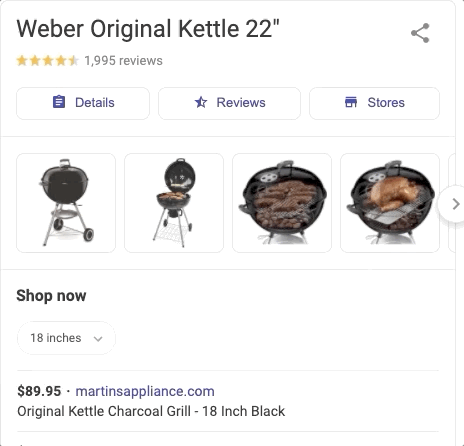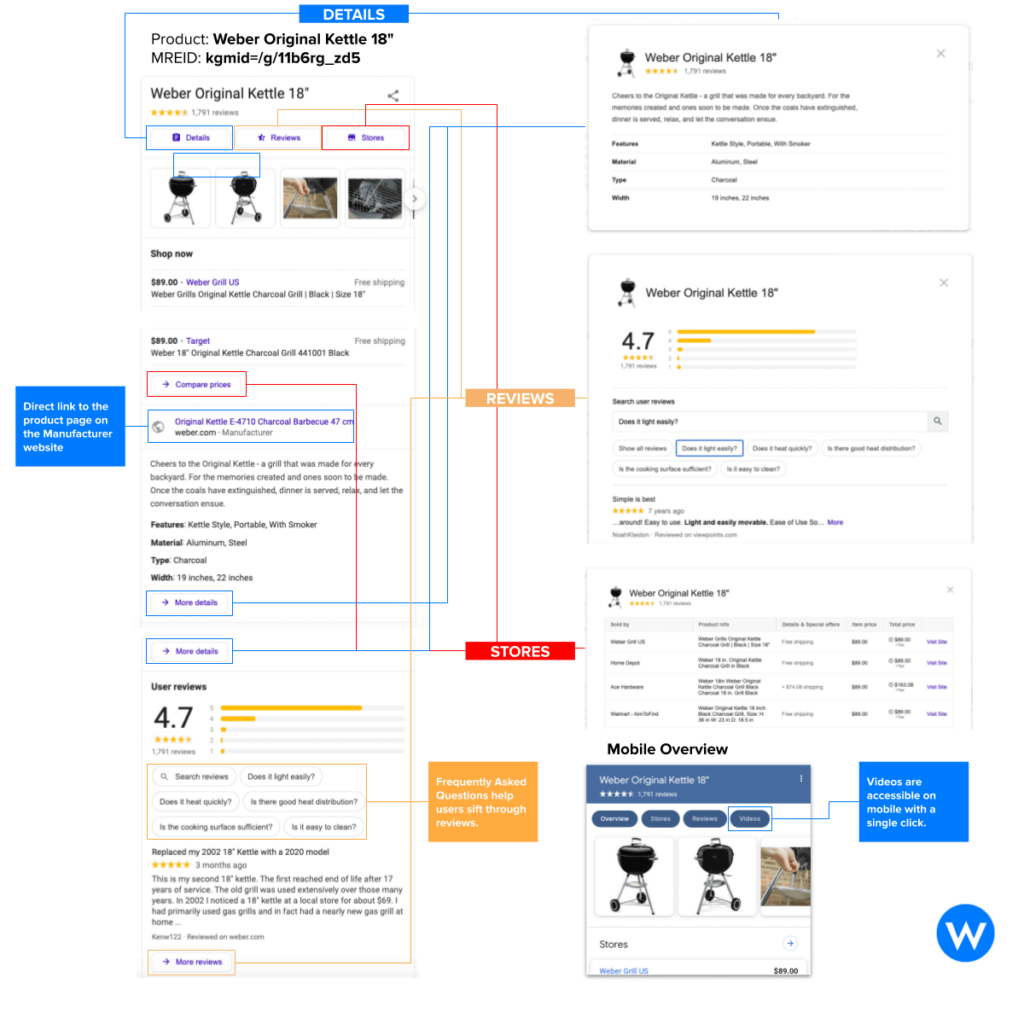Diving deep into Product Knowledge Panels
Let’s take a first look at Product Knowledge Graph Panels and how they can impact the organic traffic of your eCommerce website. Product Panels are constantly evolving and provide users with an immersive experience on Google Search.
Let’s take a first look at Product Knowledge Graph Panels and how they can impact the organic traffic of your eCommerce website. In this article I will share everything I learned on this type of rich results.
Before dissecting this new panel let’s try to define them. Product Knowledge Graph Panels are information boxes that appear on Google when you search for products that are in the Knowledge Graph. They were first introduced on mobile back in November 2017.
Get shopping information in a snap. Now with a single search, you can quickly find product photos, videos, reviews, descriptions and more. pic.twitter.com/4w0OXyvAJ2
— Google (@Google) November 14, 2017
Much like any other Knowledge Panels a Product Knowledge Panel is meant to help you get a quick snapshot of information on a specific product-entity based on Google’s understanding of the available content on the web.


This is by far the most interactive rich result that I have ever seen. The information is automatically generated, comes from various sources across the web, and allows you to quickly get access to:
- Product Details (descriptions, features, material, size, weight and a lot more depending on the product)
- Link to the official product page (this is a link to the product page on the manufacturer’s website)
- Reviews (all the reviews from different websites, organized around the most frequently asked questions – this is powerful but, hey no links here!)
- Price Comparison (the list of all the stores that sell online that product)
Panels are updated as information changes on the web and the layout – depending on the product – might also include:
- Personalized Ads (these are sponsored links that take you to the different online shops. I saw different behaviours here: ads that are separated from the panel – appearing before the panel or ads that are embedded in the “Stores” section)
- Product videos (these are introductory product videos mostly coming from YouTube that present the product)
- Accessories (these are related products that can be purchased along with the main product – in the markup the property to be used is isAccessoryOrSparePartFor – this helps you link accessories of a main product)
- Critic reviews (these are direct links to an evaluation of the product written by an accredited author, it is important to use schema.org/Review or the review property nested inside schema.org/Product)
How to optimize your content for Product Knowledge Panels
A few things are very clear so far.
1. Write product reviews and make sure to match the product that you are targeting
If you produce product reviews you have a new opportunity to gain qualified traffic as long as you use structured data markup for Product or for Review (that target a Product). Products can be reconciled using the GTIN code – this is a globally unique 14-digit number used that identifies trade items, products, or services. You can also add a sameAs link to the entity in Google’s Graph (i.e. the Weber Original Kettle 18” has its own Machine-Readable IDs kgmid=/g/11b6rg_zd5 that you can use in the schema markup).
2. Embed YouTube videos in articles using structured data
You can also get very visible by embedding in your articles YouTube videos using the VideoObject markup. Articles with embedded videos can get higher ranking than the canonical video itself (as long as the content that you produce adds value to the video) ?
I find it very interesting that it’s possible to rank #1 in the video search results by embedding a YouTube video (+Schema) & writing unique content about it.
— Lily Ray ? (@lilyraynyc) September 27, 2020
This SEJ content ranks even higher than the original YouTube video.
So yes, in this case, more content *is* better ? pic.twitter.com/rosmjEoqKS
3. Use structured data markup on all your product pages (and if you are the manufacturer…don’t forget to use the Google Manufacturer Center)
All the manufacturers will get a direct link to their product pages and yes all of this might go at the expenses retailers that – on some queries at least – will be more likely forced to spend money on advertising.
Manufacturers can also send product data using the Google Manufacturer Center, one of the most immediate and direct ways to send authoritative products information to Google. Bing also has a similar functionality but at the time of writing the website wasn’t available.
Adding structured data is essential and can help you earn the spot that you deserve. One example for all, if the panel features the “Accessories” tab; using schema markup will help Google create the link between the product articles that present the product’s accessories (hence driving more clicks to these websites) .
Here is an example of links that you can earn by helping Google understand a product’s ecosystem.
4. While critic reviews helps, customer reviews will not get you clicks
As of today user generated reviews are aggregated in the panel from multiple websites and do not have a link to the source. The content is very well organized (English only) around automatically generated queries that Google generates from all the reviews it acquires (the magical power of NLP).
Conclusions and more insights
Product Panels are completely new and provide the searcher with an immersive experience on Google Search. They are designed as a one-stop shop for products that you can buy online. Google is most probably experimenting a lot with these new rich results (I see things changing frequently especially in relationship to product ads) and metrics are still volatile.
Having said so I did a quick analysis on a manufacturer website on a cluster of 100 queries on Google.com in the US. First a disclaimer: 100 queries from a single website is a small sample and, while it cannot be considered statistically relevant, it does shed some light.
Here is what I discovered:
- Panels tend to appear on the most trafficked queries; more than half of the queries that I analysed had a panel already!!
- Impressions, when there is a panel, tend to jump (+110.85% more impressions on average when compared to queries where there is not a panel) – remember this is a manufacturer so they are always present,
- CTR goes down (-10.7% in comparison to queries with no panel) as we receive more impressions.

The most important lessons learned
- Impressions have a growing importance in evaluating your business performances, as Google drives more engagement on its SERP, your site might get less clicks but you will still close the sales;
- To close the sales and to leverage on Knowledge Panels for Products you need to create (or aggregate) great content around products in the form of reviews, videos and top notch articles that compel users to purchase. A smooth online experience is made of multiple steps and these needs to be coherent and…well connected.
High quality structured linked data along with a consistent content model can truly make a difference in helping Google understand your entities, their relationships and in the end this will help you sell more!
Willing to review the schema markup on your eCommerce website? Get in contact with our SEO management service team now!